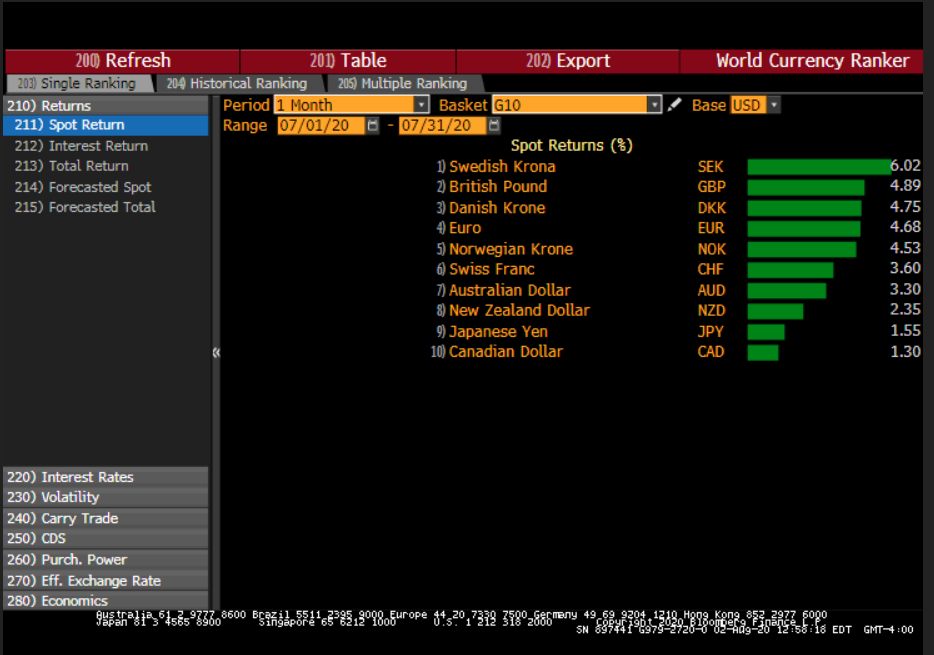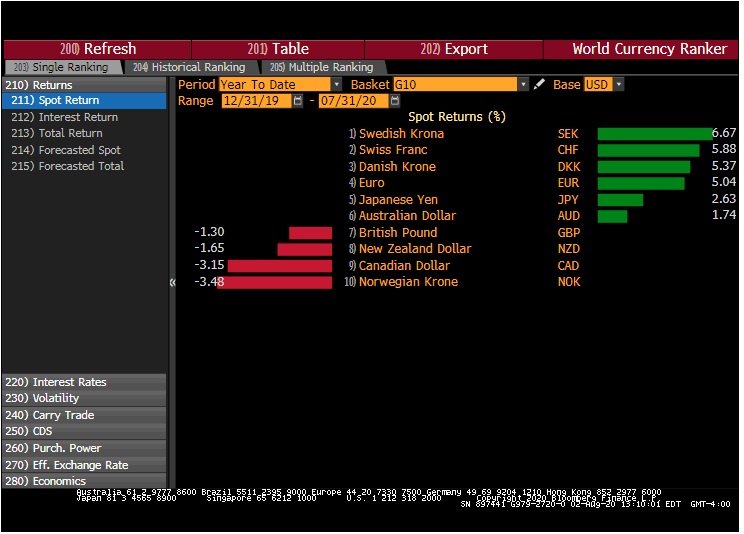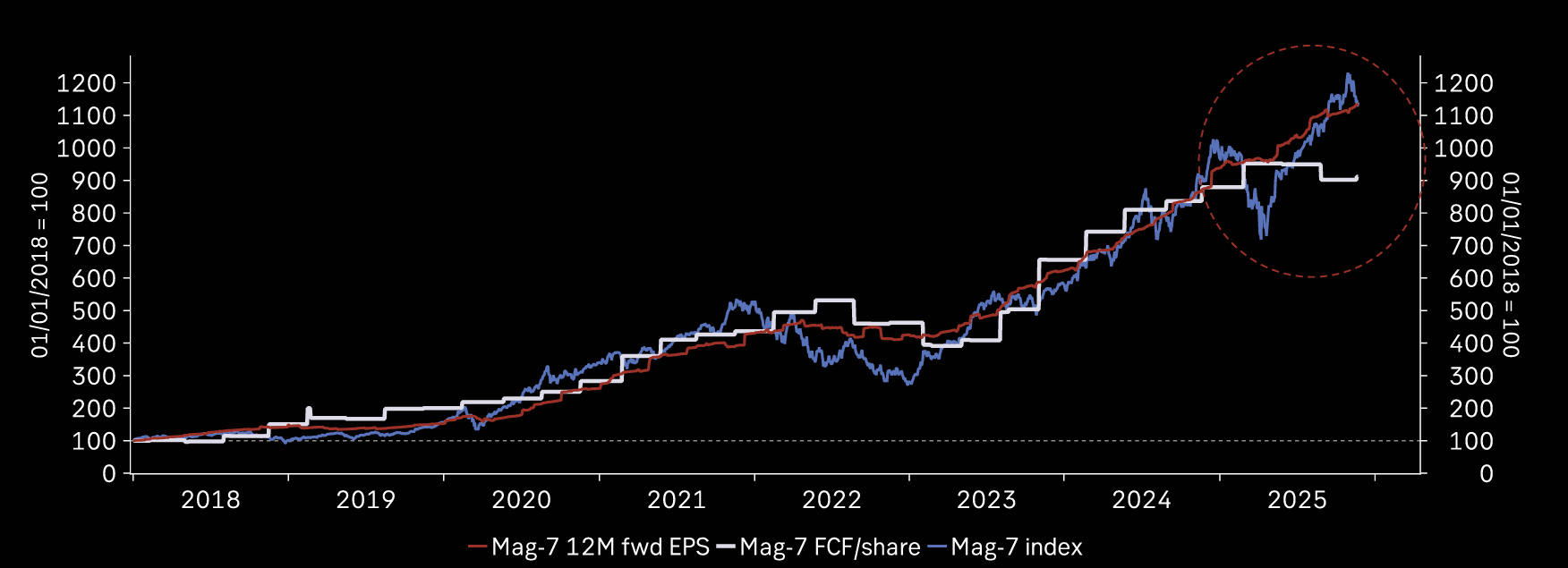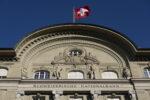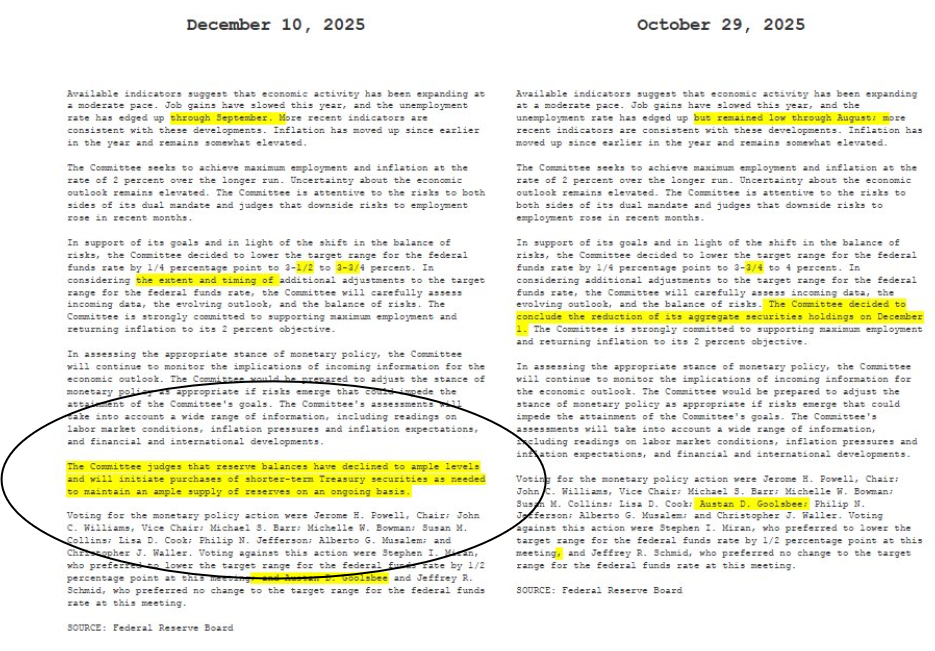Dollar: The dollar’s decline ought not to be exaggerated. In the year through July, it is stronger against the currencies of its three largest trading partners: ~15% against the Mexican peso, ~3% against the Canadian dollar, and about 0.2% against the Chinese yuan. President Trump has often advocated a weaker dollar, which is also desirable from a monetary policy point of view. The Federal Reserve appears to have laid the groundwork for more supportive action at its next FOMC meeting (mid-September). Electoral considerations may encourage Congress to approve a stimulus bill before its summer recess currently scheduled to begin August 10. In the current context, not reaching an agreement to increase the US debt, that is, provide more stimulus would likely disappoint investors, spurring a second wave of left-hand tail risk. Look for Federal Reserve official comments especially at the confab late in the month to provide some clues into the next policy steps.
Euro: The 4.7% gain in July was the euro’s best monthly performance in a decade. It gained on most of the major currencies, but the Scandis, and lagged behind the gains in the central European currencies. Europe has been an important beneficiary of the turn in dollar sentiment, which is not to diminish the role of the EU and ECB actions that coincided with an acceleration of the euro’s appreciation. If the multi-year bear market for the euro is over, these are still the early days. The average rate of the euro over its short life is about $1.20, and there may be potential toward $1.25 by the end of the year. August should be a relatively quiet month for European developments, suggesting that factors abroad and technical considerations may be the key drivers.
(end of March indicative prices, previous in parentheses)
Spot: $1.1780 ($1.1235)
Median Bloomberg One-month Forecast $1.1570 ($1.1225)
One-month forward $1.1785 ($1.1245) One-month implied vol 7.8% (7.1%)
Yen: The dollar’s roughly 2.0% decline against the yen in July is modest relative to its performance against the other major currencies but the Canadian dollar. However, it is the largest decline in a year, and most of the losses took place in the second half of July as the lower end of the JPY106-JPY108 range gave way before the dramatic snap back on the last trading day of July. While many Japanese businesses can manage with a stronger yen, as it approaches JPY100, margins may be squeezed. The yen has not only appreciated against the dollar but also appreciated most of its trading partners in Asia this year. Japanese officials may be reluctant to say much for fear of antagonizing the US. No fresh policy initiatives are expected in August, but a supplemental budget is increasingly likely in October, especially in light of the new outbreaks of the virus.
Spot: JPY105.85 (JPY107.95)
Median Bloomberg One-month Forecast JPY106.50 (JPY107.65)
One-month forward JPY105.90 (JPY107.90) One-month implied vol 7.3% (5.8%)
Sterling: The British pound underperformed in the first half. It fell 6.4% and was the second weakest major currency after the Norwegian krone at depreciated by about 8.7%. Sterling lost a little more against the euro. However, July was a different story as both the krone and sterling bounced back. The krone led the majors higher in July (+6.0%), but sterling was among the leaders as well with a gain of a little more than 4.8%. Her Majesty’s Treasury is expected to sell GBP500 bln of bonds this year and the Bank of England is committed to purchasing GBP300 bln. The Bank of England purposely refuses to rule out adopting a negative rate policy and UK yields through seven-year maturities are below zero. The Monetary Policy Committee meets on August 8 and although it is unlikely to move, the market will be watching closely for cues. August will be an important month for the UK-EU trade talks. If progress is not reported, investors may begin getting concerned about the potential disruptions.
Spot: $1.3085 ($1.2400)
Median Bloomberg One-month Forecast $1.2820 ($1.2415)
One-month forward $1.3090 ($1.2400) One-month implied vol 8.6% (9.0%)
Canadian Dollar: The Canadian dollar continued to underperform in the broad move against the US dollar. Still, it appreciated by 1.3% in July, which was the least of the major currencies. The greenback finished last year near CAD1.3000. In a soft US dollar environment, it is not uncommon for the Canadian dollar to lag behind the other majors. Although Canada appears to have fiscal space with the lowest debt/GDP ratio in the G7 (~40%), supply concerns loom. The Bank of Canada, like the Federal Reserve, is having continued discussions about yield curve control. It does not meet in August. The Canadian dollar’s correlation with the S&P 500 is near 5-6 year highs. Oil prices, and commodity prices more generally, continued to recover in July, which also appears common in a weak US dollar environment.
Spot: CAD1.3410 (CAD 1.3580)
Median Bloomberg One-month Forecast CAD1.3515 (CAD1.3585)
One-month forward CAD1.3415 (CAD1.3575) One-month implied vol 6.3% (7.0%)
Australian Dollar: July was the fourth consecutive monthly advance for the Australian dollar, during which time it has appreciated by roughly 16.5%. It is now higher for the year (~1.75%). The flare-up of the virus in Victoria means more government support is needed and the deficit for the fiscal year that is getting underway is projected to be around 10% of GDP. The government will also extend loan guarantees for small businesses and extend the Job Seeking and Job Keeping programs that were to initially terminate at the end of this quarter. The central bank could increase its bond purchases if necessary. Central Bank Governor Lowe has suggested there is room to shave the 25 bp cash rate to 10 bp, but seems reluctant to adopt negative interest rates. Separately, tensions with China are rising, and its relationship with the US, with whom it has a trade deficit, remains strong. The correlation between the Australian dollar and Chinese equities has declined for the second consecutive month.
Spot: $0.7145 ($0.6900)
Median Bloomberg One-Month Forecast $0.7035 ($0.6870)
One-month forward $0.7150 ($0.6905) One-month implied vol 10.4% (10.9%)
Mexican Peso: Banxico meets on August 13 and it has scope to cut the target rate, currently at 5%. Inflation rose to 3.3% in June and it might have accelerated a little more in early July. However, officials see deflationary forces being stronger. The economy contracted by 17.3% quarter-over-quarter in Q2 and is among the hardest-hit economies. There is probably scope for 50-75 bp off the cash rate this year. The optimists think it may take two years for output to return to pre-pandemic levels. The peso appears more a bellwether of global risk appetites than a product of domestic economic forces. The dollar fell about 3.1% against the peso in July, leaving it up about 17.7% for the year. Since the first part of June, the dollar has been confined to a broad range of roughly MXN21.45 to MXN23.23. The lower end of the range held in the second half of July, leaving it poised to test the upper end in the first part of August.
Spot: MXN22.27 (MXN22.99)
Median Bloomberg One-Month Forecast MXN22.12 (MXN22.77)
One-month forward MXN22.37 (MXN23.09) One-month implied vol 14.7% (18.8%)
Chinese Yuan: The yuan remains a closely managed currency even if direct intervention does not need to be relied upon. The 1.25% appreciation in July reflects two main forces: the dollar’s broad weakness and the rally in Chinese equities that caught many asset managers underweight. Chinese officials seemed to encourage domestic investors and raised the limit insurance companies can invest in stocks. Beijing’s monetary and fiscal response has been relatively muted, but many banks have frontloaded the lending allowed under this year’s quota and some decisions will likely be required by early Q4. For over a year, the dollar has been confined to a broad trading range of CNY6.8200 to CNY7.1850. Chinese officials are likely to ensure the adjustment is gradual.
Spot: CNY6.9750 (CNY7.0655)
Median Bloomberg One-month Forecast CNY7.0165 (CNY7.0670)
One-month forward CNY7.0795 (CNY6.9995) One-month implied vol 4.4% (4.2%)
Full story here Are you the author? Previous post See more for Next postTags: #USD,Currency Movement,Featured,newsletter









